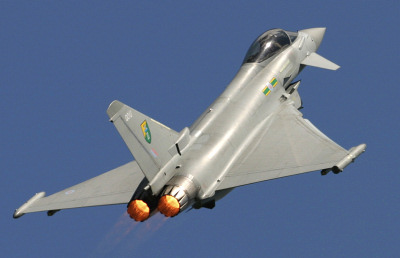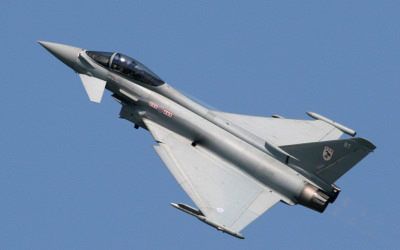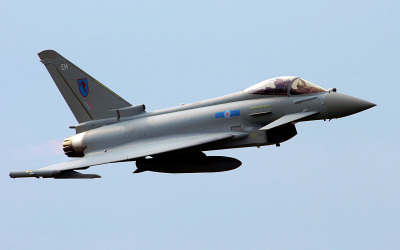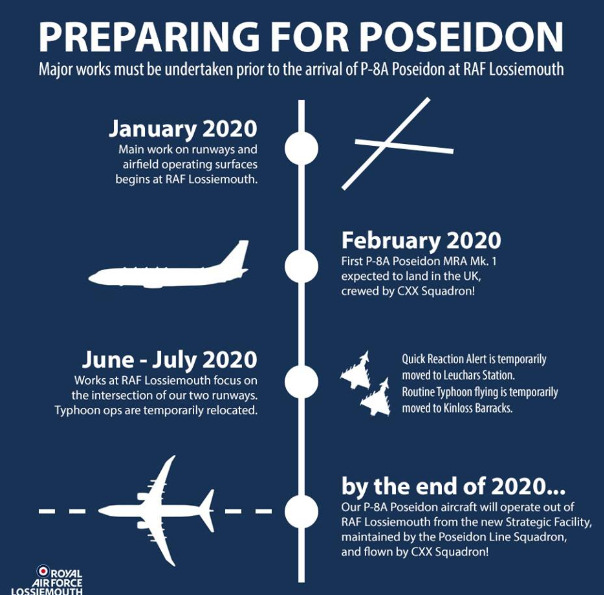RAF Lossiemouth is located north-east of Inverness in Scotland. It is one of the largest and busiest fast jet operating bases within the Royal Air Force, with four Typhoon squadrons based here.
The Typhoon Squadrons contribute to the Quick Reaction Alert (Interceptor) North capability which provides protection to UK airspace 24 hours a day, 365 days a year.
The new Poseidon P8 Maritime Patrol Aircraft are also based here and will be joined by the new E-7 Wedgetail airborne early warning and control aircraft.
RAF Lossiemouth Satellite View
Military Aircraft Tracker in the UK
 • Current Military Aircraft in the UK Tracker.
• Current Military Aircraft in the UK Tracker.
• Historic Military Aircraft in the UK Tracker.
• Military Aircraft around the World Tracker.
Live Trackers
When using ADS-B Exchange Tracker then click on 'U' to see military aircraft.
Scanner Frequencies
RAF Lossiemouth Scanner Frequencies:
Approach - 315.150, *362.200, 362.775, *123.300
Director - 277.525, *123.300
Departures - 308.850, *123.300
PAR - 378.775, 255.925, *123.300
Tower - 118.900, 279.050
Ground - 268.625, 118.900
OPS - 291.150
ATIS - 369.150
*= NATO Common Frequency
|
Military Aircraft Photographs at UK Military Bases
Aircraft & Squadrons
RAF Lossiemouth is home to four Typhoon Squadrons (1 Sqn, 2 Sqn, 6 Sqn & 9 Sqn). No. IX(B) Squadron formally re-equipped as an 'aggressor' and 'air defence squadron' operating Eurofighter Typhoon Tranche 1 in April 2019.
Nine new Poseidon P8 Maritime Patrol Aircraft, known as the Poseidon MRA Mk.1 in RAF service, were delivered to the RAF, from 2019/2020, and stationed at RAF Lossiemouth. These aircraft are to protect the UK's nuclear deterrent and new aircraft carriers, as well as perform Maritime Patrol, Anti-submarine Warfare & Search-and-Rescue. They form two squadrons at Lossiemouth with 120 Squadron and 201 Squadron. 54 Squadron, based at RAF Waddington, will serve as the Operational Conversion Unit (OCU).
• Click here for more info on the RAF Poseidon MRA1.
42 Squadron reformed at RAF Lossiemouth on 21 September 2023 as the Operational Conversion Unit for both the Boeing Poseidon MRA1 and Boeing Wedgetail AEW1.
Additional units at RAF Lossiemouth include No 5 Force Protection Wing, the RAF Lossiemouth Mountain Rescue Team and the Highland Wing Headquarters of the Air Training Corps.
• 1(F) Squadron - Typhoon.
• II(AC) Squadron - Typhoon.
• 6 Squadron - Typhoon.
• IX(B) Squadron - Typhoon (Aggressor Squadron & QRA).
• CXX Squadron - Poseidon MRA1.
• 201 Squadron - Poseidon MRA1.
• 42 Squadron OCU - Poseidon & E-7 Wedgetail.
The E-3D Sentry AWACS aircraft at
RAF Waddington will be replaced with
three new E-7 Wedgetail airborne early warning and control aircraft in 2024, which will be based at RAF Lossiemouth, with 8 Squadron. More info
here. The RAF's Wedgetail E7 AEW Mk1 aircraft has made its maiden test flight from Birmingham Airport on 24.9.24. A key E-7 Wedgetail facility was also officially opened by the RAF in September 2024.
History
RAF Lossiemouth was formally opened in 1939 with No.15 Flight Training School (FTS) operating Airspeed Oxfords, and Hawker Harts.
During the War, anti-aircraft defences were installed and 15 FTS received more Airspeed Oxfords, and Hawker Harts. Fairey Battles were also stored at the base. Wellington bombers were based here for a short time as they took part in the attack of German cruiser Deutschland.
In 1940, a detachment of Handley Page Hampdens took part in offensive patrols over the North Sea. The Wellingtons were replaced by Bristol Blenheims. 15 FTS was then relocated to Middle Wallop and RAF Lossiemouth transferred to No 6 Group of RAF Bomber Command operating Wellingtons and Avro Ansons.
46 Maintenance Unit (MU) was formed in 1940 to service Hurricanes, Tiger Moths, Hawker Audaxes, and a Hornet Moth. There were continued bomber detachments in 1941 using Blenheims. In 1942, several unsuccessful missions were undertaken to sink the German Battleship Tirpitz using Stirling and Halifax bombers, and later Lancasters. Wellingtons were also used in strategic bombing of German cities in 1942.
The US Army Air Force constructed the airfields first surfaced runways as well as a new control tower in late 1942. 46 MU worked on Bristol Beaufighters and Lancasters during 1943. Further operations against Tirpitz took place in 1944 from Lossiemouth as well as Kinloss and Milltown which successfully destroyed the Battleship using Lancasters with Tallboy bombs.
After the War, 46 MU began the enormous task of breaking up surplus aircraft for scrap. RAF Lossiemouth was transferred to No 17 Group of RAF Coastal Command, and operated B-24 Liberators, Halifaxes, and a B-25 Mitchell until they were disbanded in 1946.
Lossiemouth was transferred from the Royal Air Force to the Fleet Air Arm in 1946 and was a training station known as HMS Fulmar. Supermarine Seafires and Fairey Fireflies were operated here until 1953. In 1967, Blackburn Buccaneer aircraft bombed the shipwrecked supertanker Torrey Canyon off the west of Cornwall to avoid an enviromental disaster.
The station was transferred back to the Royal Air Force in 1972 and a Helicopter Search and Rescue flight took up residence. The base also operated the Avro Shackleton. From 1978 to 1981 the Hawker Hunter was based here. In 1993, the Buccaneers were replaced by Tornados in the anti-shipping role. It was announced in 2011 that Lossiemouth's Tornados would move to RAF Marham and RAF Leuchars would close and move their Typhoons to RAF Lossiemouth.


 RAF Typhoon.
RAF Typhoon.
 RAF Typhoon.
RAF Typhoon.
 RAF Typhoon.
RAF Typhoon.


